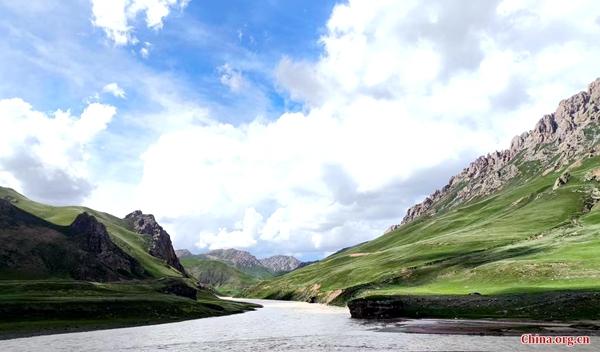
 0 Comment(s)
0 Comment(s) Print
Print E-mail China.org.cn, July 19, 2024
E-mail China.org.cn, July 19, 2024
A branch of the Lancang River, Qinghai province, July 17, 2024. [Photo by Xu Xiaoxuan/China.org.cn]
"This joint survey on the source of the Lancang River aims to help the five Mekong countries better understand the development and ecological conservation efforts China has made along the river. After all, seeing is believing," noted Cheng Dongsheng, director of the Training and Information Department of the Lancang-Mekong Water Resources Cooperation Center, during the joint survey by the six Lancang-Mekong countries which began Monday in northwestern China's Qinghai province.
The Mekong River, known as the Lancang River in China, is a vital waterway flowing through China, Myanmar, Laos, Thailand, Cambodia and Vietnam. The six countries launched the Lancang-Mekong Cooperation mechanism in 2016, and the Lancang-Mekong Water Resources Cooperation Center was established in 2017 under this framework.
"The Lancang-Mekong River Basin is among the regions most significantly impacted by climate change, and is frequently threatened by both droughts and floods, which substantially affect the lives and economic development of local residents," Cheng told China.org.cn in an exclusive interview. "Therefore, comprehensive flood and drought control cooperation across the entire basin is vital."
However, some misunderstandings persist in the Mekong countries, influenced by certain Western media narratives regarding China's activities along the Lancang River. Some reports claim that dams built by China affect navigation and water quality, and cause droughts. For instance, the Mekong Dam Monitor platform led by U.S. think tank the Stimson Center released inaccurate hydrological data regarding the Mekong Basin, creating a misleading "water narrative war."
In reality, the hydropower stations operating on the Lancang River do not consume water, but instead scientifically regulate river runoff. Cheng explained that these hydropower stations store water to reduce discharge during the flood season and then increase discharge during the dry season. This regulation raises water levels in the Mekong River during the dry season and alleviates flood control pressure during the flood season, thereby improving the livelihoods of people in the region.
"For example, under natural conditions, the water flow downstream during the dry season could be as low as 300-400 cubic meters per second, but with the regulation of water facilities, the flow can reach 1,500 cubic meters per second," Cheng said.
Lancang-Mekong water resources cooperation has yielded significant results beyond flood and drought control. Since 2017, the Chinese government has helped implement over 50 livelihood demonstration projects for the Mekong countries, encompassing rural water supply safety, small basin comprehensive management, dam safety monitoring, and personnel training.
These projects have delivered tangible benefits to residents. For instance, the Lancang-Mekong Sweet Spring Project, funded by the Chinese government, has built more than 60 rural water supply safety demonstration sites in Mekong countries, ensuring safe drinking water for more than 10,000 locals. This project was included in the list of practical cooperation deliverables during the third Belt and Road Forum for International Cooperation in 2023.
Lancang-Mekong hydropower cooperation has also enhanced people's well-being. "The economic and social development of the Lancang-Mekong countries requires substantial energy. Countries such as Laos, Myanmar and Cambodia face energy shortages to some extent," Cheng said, adding that hydropower development can greatly alleviate these shortages.
Cheng emphasized the importance of balancing water resources development with ecological conservation. Qinghai is home to the Sanjiangyuan area, which is the source of the Yangtze, Yellow and Lancang rivers. Since the Sanjiangyuan National Park was established in 2021, 1,950,000 mu (13,000 hectares) of degraded grassland has been restored, and 110,000 mu of land has undergone desertification control. The Tibetan antelope population has grown from less than 20,000 to over 70,000 .
Additionally, the six Lancang-Mekong countries are jointly enhancing the Lancang-Mekong Water Resources Cooperation Information Sharing Platform. Since 2002, the Chinese Ministry of Water Resources has regularly provided the Mekong River Commission Secretariat with hydrological data for the Lancang-Mekong River during the flood season. Since November 2020, it has also been providing year-round hydrological information.
The evaluation on the implementation of the five-year action plan on Lancang-Mekong water resources cooperation (2018-2022) was released last year, which was highly commended by the six Lancang-Mekong countries. These countries agreed that collaboration and mutual benefit, openness and inclusiveness, and balanced development and conservation are of great importance.
Looking ahead, water resources cooperation in the Lancang-Mekong region will continue under the framework of the new five-year action plan (2023-2027), focusing on water resources protection and green development, climate change response, water infrastructure development, rural water supply and livelihood improvement, energy security, and cross-border river information sharing.
"Lancang-Mekong water resources cooperation is a win-win endeavor, and each country plays an indispensable role," Cheng concluded.